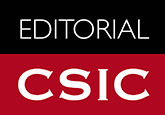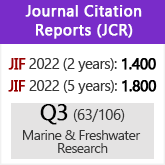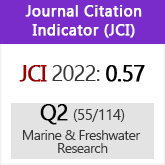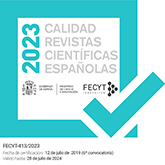Ecology of megabenthic bivalve communities from sandy beaches on the south coast of Portugal
DOI:
https://doi.org/10.3989/scimar.2010.74n1163Keywords:
bivalves, geographic distribution, bathymetric distribution, beach morphology, river proximityAbstract
Ecological aspects of 75 megabenthic bivalve species found on the south coast of Portugal (from Vila Real to Sagres) were studied based on the information provided by seasonal bivalve surveys from 2000 to 2007 (8600 hauls, simultaneously using a razor shell dredge and a clam dredge). Of the 75 species identified, 36 occurred less than 30 times, and thus were considered rare in the area. The remaining 39 bivalves were analysed according to their occurrence, bathymetric distribution, geographic preferences, seasonal preferences, burying-depth, beach exposure and river mouth proximity. All species belonging to the Pharidae and Solenidae families (razor shells) and most Tellinidae were significantly more frequent in the razor shell dredge (indicating deeper burying in the sediment), whilst the families Cardiidae and Donacidae were significantly more frequent in the clam dredge (indicating that these species are probably closer to the sediment surface). As for the season, most bivalve species occurred similarly in both seasons (19 sp; 49%), but a large proportion were more abundant during the autumn surveys (17 sp., 44%), whereas only three species were commoner during the spring surveys. Most species belonging to the families Cardiidae and Mactridae were commoner in the autumn surveys. The spatial distribution differed between species and cluster analysis identified four communities with greater geographic affinity. Species belonging to the family Cardiidae were preferably found in the western part (WB) and the eastern part (S) of the study area, whereas the families Donacidae, Mactridae and Tellinidae occurred mainly in the central area (EB) and the eastern (S) coastal sectors. Overall, shallower species (modal depth at 3-6 m) showed greater occurrences and abundances than the deeper ones, and the depth pattern observed did not change between seasons. Donacidae and Mactridae (except Mactra glauca) were represented essentially by shallow species, whereas Cardiidae (except Acanthocardia tuberculata and Cerastoderma edule) included mostly species occurring in deeper waters. Bathymetric sequence of species distribution within some families was observed.
Downloads
References
Abelló, P., A. Carbonell and P. Torres. – 2002. Biogeography of epibenthic crustaceans on the shelf and upper slope off the Iberian Peninsula Mediterranean coasts: implications for the establishment of natural management areas. Sci. Mar., 66(suppl.2): 183-198. doi:10.3989/scimar.2002.66s2183
Ambrogi, R. and A.O. Ambrogi. – 1987. Temporal variations of the secondary production in the marine bivalve Spisula subtruncata off the Po river delta (Italy). Estuar. Coast. Shelf Sci., 1987: 369-379. doi:10.1016/0272-7714(87)90079-5
Ansell, A.D., C.A. Comely and L. Robb. – 1999. Distribution, movements and diet of macrocrustaceans on a Scottish sandy beach with particular reference to predation on juvenile fishes. Mar. Ecol. Prog. Ser., 176: 115-130. doi:10.3354/meps176115
Backeljau, T., P. Bouchet, S. Gofas and L. de Bruyn. – 1994. Genetic variation, systematics and distribution of the venerid clam Chamelea gallina. J. Mar. Biol. Ass. U.K., 74: 211-223. doi:10.1017/S0025315400035773
Brazeiro, A. and O. Defeo. – 1996. Macroinfauna zonation in microtidal sandy beaches: is it possible to identify patterns in such variable environments? Estuar. Coast. Shelf Sci., 42: 523-536. doi:10.1006/ecss.1996.0033
Cabaço, S., R. Machás, V. Vieira and R. Santos. – 2008. Impacts of urban wastewater discharge on seagrass meadows (Zostera noltii). Estuar. Coast. Shelf Sci., 78: 1-13.
Chícharo, L., J. Regala, M. Gaspar, F. Alves and A. Chícharo. _ 2002. Macrofauna spatial differences within clam dredge-tracks and their implications for short-term fishing effect studies. Fish. Res., 54: 349-354. doi:10.1016/S0165-7836(01)00272-7
Ciavola, P., R. Taborda, O. Ferreira and J.A. Dias. – 1997. Field observations of sand-mixing depths on steep beaches. Mar. Geol., 141: 147-156. doi:10.1016/S0025-3227(97)00054-6
Costa, M. – 1994. Agitação marítima na costa portuguesa. An. Inst. Hid. Lisb., 13: 35-40.
Cravo, A., M. Madureira, H. Felicia, F. Rita and M.J. Bebianno. – 2006. Impact of outflow from the Guadiana River on the distribution of suspended particulate matter and nutrients in the adjacent coastal zone. Estuar. Coast. Shelf Sci., 70: 63-75. doi:10.1016/j.ecss.2006.05.034
De Goeij, P. and P. Luttikhuizen. – 1998. Deep-burying reduces growth in intertidal bivalves: field and mesocosm experiments with Macoma balthica. J. Exp. Mar. Biol. Ecol., 228: 327-337. doi:10.1016/S0022-0981(98)00062-8
Defeo, O. and A. McLachlan. – 2005. Patterns, processes and regulatory mechanisms in sandy beach macrofauna: a multi-scale analysis. Mar. Ecol. Prog. Ser., 295: 1-20. doi:10.3354/meps295001
Dexter, D.M. – 1992. Sandy beach community structure: the role of exposure and latitude. J. Biogeogr., 19: 59-66. doi:10.2307/2845620
Erzini, K. – 2005. Trends in NEAtlantic landings (southern Portugal): identifying the relative importance of fisheries and environmental variables. Fish. Oceanogr., 14: 195-209. doi:10.1111/j.1365-2419.2005.00332.x
Fugi, T. – 2007. Spatial patterns of benthic macrofauna in relation to environmental variables in an intertidal habitat in the Humber estuary, UK: Developing a tool for estuarine shoreline management. Estuar. Coast. Shelf Sci., 75: 101-119. doi:10.1016/j.ecss.2007.02.027
Gaspar, M.B. – 1996. Bivalves do litoral oceânico algarvio. Aspectos da biologia, ecologia e das pescarias dos mananciais de interesse económico: aplicacão à gestão dos recursos. Ph.D. thesis, Univ. Algarve.
Gaspar, M.B. and C.C. Monteiro. – 1998. Reproductive cycles of the razor clam Ensis siliqua and the clam Venus striatula off Vilamoura, southern Portugal. J. Mar. Biol. Assoc. U.K., 78: 1247-1258. doi:10.1017/S0025315400044465
Gaspar, M.B., M. Castro and C.C. Monteiro. – 1999a. Effect of tooth spacing and mesh size on the catch of the Portuguese clam and razor clam dredge. ICES J. Mar. Sci., 56: 103-110. doi:10.1006/jmsc.1998.0423
Gaspar, M.B., R. Ferreira and C.C. Monteiro. – 1999b. Growth and reproductive cycle of Donax trunculus L., (Mollusca: Bivalvia) off Faro, southern Portugal. Fish. Res., 41: 309-316. doi:10.1016/S0165-7836(99)00017-X
Gaspar, M.B., L.M. Chícharo, P. Vasconcelos, A. Garcia, A.R. Santos and C.C. Monteiro. – 2002a. Depth segregation phenomenon in Donax trunculus (Bivalvia: Donacidae) populations of the Algarve coast (southern Portugal). Sci. Mar., 66: 111-121. doi:10.3989/scimar.2002.66n2111
Gaspar, M.B., F. Leitao, M.N. Santos, M. Sobral, L. Chícharo, A. Chícharo and C.C. Monteiro. – 2002b. Influence of mesh size and tooth spacing on the proportion of damaged organisms in the catches of the Portuguese clam dredge fishery. ICES J. Mar. Sci., 59: 1228-1236. doi:10.1006/jmsc.2002.1310
Gaspar, M.B., F. Leitao, M.N. Santos, L. Chícharo, M.D. Dias, A. Chícharo and C.C. Monteiro. – 2003. Acomparison of direct macrofaunal mortality using three types of clam dredges. ICES J. Mar. Sci., 60: 733-742. doi:10.1016/S1054-3139(03)00023-7
Gibson, R.N. – 2003. Go with the flow: tidal migrations in marine animals. Hydrobiologia, 503: 153-161. doi:10.1023/B:HYDR.0000008488.33614.62
Grémare, A., J.M. Amouroux and G. Vetion. _ 1998. Long-term comparison of macrobenthos within the soft bottoms of the Bay of Banyuls-sur-mer (northwestern Mediterranean Sea). J. Sea Res., 40: 281-302. doi:10.1016/S1385-1101(98)00032-X
Guillou, J. and P.G. Sauriau. – 1985. Some observations on the biology and the ecology of a Venus striatula population in the Bay of Douarnenez, Brittany. J. Mar. Biol. Assoc. U.K., 65: 889-900. doi:10.1017/S0025315400019391
Harriague, A., L. Gaozza, A. Montella and C. Misic. – 2006. Benthic communities on a sandy Ligurian beach (NW Mediterranean). Hydrobiologia, 571: 383-394. doi:10.1007/s10750-006-0264-3
Hiddink, J.G. and W.J. Wolff. – 2002. Changes in distribution and decrease in numbers during migration of the bivalve Macoma balthica. Mar. Ecol. Prog. Ser., 233: 117-130. doi:10.3354/meps233117
Hiddink, J., R. Kock and W. Wolff. – 2002. Active pelagic migrations of the bivalve Macoma balthica are dangerous. Mar. Biol. (N Y), 140: 1149-1156.
Huz, R., M. Lastra and J. Lopez. – 2002. The influence of sediment grain size on burrowing, growth and metabolism of Donax trunculus L. (Bivalvia: Donacidae). J. Sea Res., 47: 85-95. doi:10.1016/S1385-1101(02)00108-9
Laudien, J., M. Rojo, M. Oliva, W. Arntz and S. Thatje. – 2007. Sublittoral soft bottom communities and diversity of Mejillones Bay in northern Chile (Humboldt Current upwelling system). Helgol. Mar. Res., 61: 103-116. doi:10.1007/s10152-007-0057-8
Macedo, M.C.C., M.I.C. Macedo and J.P. Borges. – 1999. Conchas Marinhas de Portugal. Ed. Verbo, Lisboa.
McBreen, F., J. Wilson, A. Mackie and C. Nic Aonghusa. – 2008. Seabed mapping in the southern Irish Sea: predicting benthic biological communities based on sediment characteristics. Hydrobiologia, 606: 93-103. doi:10.1007/s10750-008-9341-0
McLachlan, A. – 1990. Dissipative beaches and macrofauna communities on exposed intertidal sands. J. Coast. Res., 6: 57-71.
McLachlan, A. and A. Dorvlo. – 2007a. Global patterns in sandy beach macrobenthic communities. J. Coast. Res., 21: 674-687. doi:10.2112/03-0114.1
McLachlan, A. and A. Dorvlo. – 2007b. Global patterns in sandy beach macrobenthic communities: Biological factors. J. Coast. Res., 23: 1081-1087. doi:10.2112/04-0408.1
McLachlan, A. and N. Young. – 1982. Effects of low temperature on the burrowing rates of four sandy beach molluscs. J. Exp. Mar. Biol. Ecol., 65: 275-284. doi:10.1016/0022-0981(82)90059-4
McLachlan, A., E. Jaramillo, O. Defeo, J. Dugan, A. de Ruyck and P. Coetzee. – 1995. Adaptations of bivalves to different beach types. J. Exp. Mar. Biol. Ecol., 187: 147-160. doi:10.1016/0022-0981(94)00176-E
Moita, I. – 1986. Carta dos sedimentos superfiais. Notícia explicativa da folha SED7 e 8. Instituto Hidrográfico, Lisboa. 18.
Moura, D., L. Albardeiro, C. Veiga-Pires, T. Boski and E. Tigano. – 2006. Morphological features and processes in the central Algarve rocky coast (South Portugal). Geomorphology, 81: 345-360. doi:10.1016/j.geomorph.2006.04.014
Neuberger Cywiak, L., Y. Achituv and L. Mizrahi. – 1990. The ecology of Donax trunculus Linnaeus and Donax semistriatus Poli from the Mediterranean coast of Israel. J. Exp. Mar. Biol. Ecol., 134: 203-220. doi:10.1016/0022-0981(89)90070-1
Newton, A. and S.M. Mudge. – 2005. Lagoon-sea exchanges, nutrient dynamics and water quality management of the Ria Formosa (Portugal). Estuar. Coast. Shelf Sci., 62: 405-414. doi:10.1016/j.ecss.2004.09.005
Noy-Meir, I. – 1979. Structure and function of desert ecosystems. Israel J Bot 28:1-19. J. Botany, 28: 1-19.
Nunes, M. _ 2007. Hazard assessment in Galé-Olhos de Água sea clifs: a tool for coastal management. Master thesis, University of Portsmouth, Faculty of Science, Department of Geography and Univ. Algarve.
Oksanen, J., R. Kindt, P. Legendre and R.B. O’Hara. – 2007. Vegan: Community Ecology Package version 1.8-5. http://cran.r-project.org/.
Pearson, T. and H.P. Mannvik. – 1998. Long-term changes in the diversity and faunal structure of benthic communities in the northern North Sea: natural variability or induced instability? Hydrobiologia. 375-376: 317-329. doi:10.1023/A:1017009022463
Pires, H.N.O. – 1989. Oclima de Portugal, Alguns Aspectos do Clima de Agitação Marítima de Interesse para a Navegação na Costa de Portugal, 34 pp. Instituto Nacional de Meteorologia e Geofísica (INMG). Lisboa
R-project. – 2006. RDevelopment Core Team R: Alanguage and environment for statistical computing. RFoundation for Statistical Computing, Vienna, Austria. ISBN3-900051-07-0, URL http://www.R-project.org.
Reise, K. – 2002. Sediment mediated species interactions in coastal waters. J. Sea Res., 48: 127-141. doi:10.1016/S1385-1101(02)00150-8
Reyes, J.L., J.T. Martins, J. Benavente, Ó. Ferreira, F.J. Gracia, J.M. Alveirinho-Dias and F. López-Aguayo. – 1999. Gulf of Cadiz beaches: Acomparative response to storm events Bol. Inst. Esp. Oceanogr., 15: 221-228.
Rufino, M.M., M.B. Gaspar, A.M. Pereira and P. Vasconcelos. – 2007. The use of shape to distinguish Chamelea gallina and Chamelea striatula (Bivalvia: Veneridae): linear and geometric morphometric methods. J. Morphol., 267: 1433-1440. doi:10.1002/jmor.10489
Rufino, M.M., M. Gaspar, F. Maynou and C.C. Monteiro. – 2008. Regional and temporal changes in bivalve diversity in the south coast of Portugal. Est. Coast. Shelf Sci., 80: 517-528. doi:10.1016/j.ecss.2008.09.014
Savazzi, E. – 1985. Adaptive themes in cardiid bivalves. Neues Jahrbuch für Geologie und Paläontologie Abhandlungen. 170: 291-321.
Schoeman, D.S. and A.J. Richardson. – 2002. Investigating biotic and abiotic factors affecting the recruitment of an intertidal clam on an exposed sandy beach using a generalized additive model. J. Exp. Mar. Biol. Ecol., 276: 67-81. doi:10.1016/S0022-0981(02)00239-3
Simboura, N. and A. Zenetos. – 2002. Benthic indicators to use in Ecological Quality classification of Mediterranean soft bottom marine ecosystems, including a new Biotic Index. Medit. Mar. Sci., 3/2: 77-111.
Tallqvist, M. – 2001. Burrowing behaviour of the Baltic clam Macoma balthica: effects of sediment type, hypoxia and predator presence. Mar. Ecol. Prog. Ser., 212: 183-191. doi:10.3354/meps212183
Teske, P.R. and T. Wooldridge. – 2001. Acomparison of the macrobenthic faunas of permanently open and temporarily open/closed South African estuaries. Hydrobiologia, 464: 227-243. doi:10.1023/A:1013995302300
Thrush, S.F., R.D. Pridmore and J.E. Hewitt. – 1994. Impacts on soft-sediment macrofauna: the effects of spatial variation on temporal trends. Ecol. Appl., 4: 31-41. doi:10.2307/1942112
Urban, H.J. – 1994. Adaptations of six infaunal bivalve species of Chile: Coexistence resulting from differences in morphology, burrowing depth and substrate preference. Arch. Fish. Mar. Res., 42: 183-193.
Vila-Concejo, A., A. Matias, Ó. Ferreira, C. Duarte and J.M.A. Dias. – 2002. Recent Evolution of the Natural Inlets of a Barrier Island System in Southern Portugal. J. Coast. Res., 36: 741-752.
Vila-Concejo, A., O. Ferreira, A. Matias and J.M.A. Dias. – 2003. The first two years of an inlet: sedimentary dynamics. Cont. Shelf Res., 23: 1425-1445. doi:10.1016/S0278-4343(03)00142-0
Vila-Concejo, A., A. Matias, A. Pacheco, O. Ferreira and J.A. Dias. – 2006. Quantification of inlet-related hazards in barrier island systems. An example from the Ria Formosa (Portugal). Cont. Shelf Res., 26: 1045-1060. doi:10.1016/j.csr.2005.12.014
Watters, G.T. – 1994. Form and function of unionoidean shell sculpture and shape (Bivalvia). Am. Malacol. Bull., 11: 1-20.
Zeichen, M.M., S. Agnesi, A. Mariani, A. Maccaroni and G.D. Ardizzone. – 2002. Biology and population dynamics of Donax trunculus L. (Bivalvia: Donacidae) in the South Adriatic Coast (Italy). Est. Coast. Shelf Sci., 54: 971-982. doi:10.1006/ecss.2001.0868
Zwarts, L. – 1986. Burying depth of the benthic bivalve Scrobicularia plana (da Costa) in relation to siphon-cropping. J. Exp. Mar. Biol. Ecol., 101: 25-39. doi:10.1016/0022-0981(86)90040-7
Zwarts, L. and J. Wanink. – 1989. Siphon size and burying depth in deposit- and suspension-feeding benthic bivalves. Mar. Biol., 100: 227-240. doi:10.1007/BF00391963
Downloads
Published
How to Cite
Issue
Section
License
Copyright (c) 2010 Consejo Superior de Investigaciones Científicas (CSIC)

This work is licensed under a Creative Commons Attribution 4.0 International License.
© CSIC. Manuscripts published in both the printed and online versions of this Journal are the property of Consejo Superior de Investigaciones Científicas, and quoting this source is a requirement for any partial or full reproduction.All contents of this electronic edition, except where otherwise noted, are distributed under a “Creative Commons Attribution 4.0 International” (CC BY 4.0) License. You may read here the basic information and the legal text of the license. The indication of the CC BY 4.0 License must be expressly stated in this way when necessary.
Self-archiving in repositories, personal webpages or similar, of any version other than the published by the Editor, is not allowed.
















